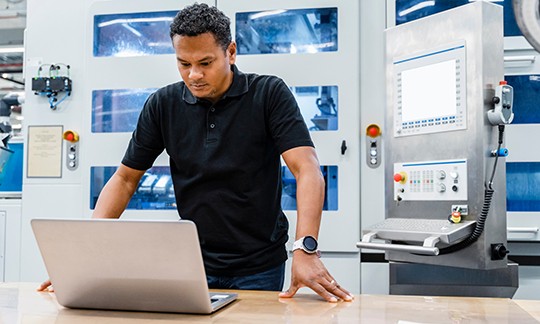
Accelerating Wireless Innovation: Qualcomm’s Strategy for Smarter, Faster Validation
CUSTOMER STORY
SEMICONDUCTOR | 5 MINUTE READ
See how Qualcomm cut RF validation time by 30% with a scalable, intelligent test strategy powered by NI tools and global collaboration.
Qualcomm has long been a driving force in wireless innovation, shaping the digital landscape with every generational leap. From its roots in CDMA and 2G to pioneering advancements in 5G—and now leading the charge in 6G—Qualcomm has evolved into a connected compute powerhouse. Its leadership spans mobile, automotive, and advanced wireless technologies.
Behind every Qualcomm breakthrough lies a rigorous validation process that must evolve as fast as the technology itself, which is where principal engineers Bertram Joseph and Luis Reyes come in. Bertram leads power management IC (PMIC) validation, ensuring devices use and distribute power efficiently. Luis focuses on radio frequency (RF) and wireless validation, where signal fidelity and performance define the user experience. They represent two distinct yet interdependent parts of Qualcomm’s semiconductor chain; together they have cracked the code on faster, smarter validation.
Parallel Paths and Shared Pressures
As Qualcomm expanded beyond mobile into new markets like automotive and computing, its product validation strategy was put to the test. Wireless protocols were evolving rapidly. Devices were becoming more diverse in form and function. Validation teams were stretched across continents, time zones, and technical domains.
Traditional validation methods—built around isolated benches and siloed software—could not scale to manage this complexity. Different teams used different instruments, code couldn’t be reused, and measurements were hard to synchronize. These inefficiencies led to longer timelines, inconsistent data, and reduced agility in adapting to new standards.
To keep pace, Qualcomm needed more than incremental improvements—it needed a unified, forward-looking test strategy.
Shifting to an Intelligent Test Approach
Qualcomm made a strategic move to regain momentum, transitioning from isolated test environments to a connected, modular approach. The goal: Build a validation infrastructure that could scale globally and evolve with product innovation.
Luis and Bertram’s teams work closely, align on roadmaps, and share best practices. As both the industry and Qualcomm’s markets have evolved, it’s become more critical to replicate and reuse a common set of validation tools and software. This shift toward an intelligent approach to test marked a philosophical shift for Qualcomm, centered on the three guiding principles: automation, standardization, and strategic reuse.
RF Innovation: From 5G to mmWave and Beyond
In the RF space, Qualcomm had already standardized on the NI PXI Vector Signal Transceiver (VST) and NI RFmx measurement software to enable high-performance, software-configurable testing. The emergence of 5G mmWave, however, introduced new challenges.
“The lower and higher bands couldn’t be validated with the same instrumentation. We needed a new level of performance,” said Luis.
The solution: upgrade to third-generation NI VSTs, purpose-built for the demands of next-generation wireless technologies.
With increased bandwidth, improved phase noise performance, and tighter integration, the latest VST gives Qualcomm the flexibility to validate future wireless standards without overhauling their entire bench. As Luis put it simply, “This upgrade ensures our RF benches are ready for what’s next.”
Power Management: Scaling Across New Domains
On the PMIC side, the transformation was just as dramatic. Qualcomm’s early power components were designed primarily for cellular applications. However, as the company expanded into automotive and computing, application requirements began to diverge. Products became more varied, and time-to-market pressures intensified.
To keep up, Qualcomm adopted cutting-edge co-packaging technologies, combining multiple semiconductor dies into a single package to deliver new functionality faster. These evolving configurations demand an equally flexible and high-performance test infrastructure.
“Our old high-power box instruments lacked the speed and integrated measurement performance we needed,” Bertram explained. “We were hitting a bottleneck.”
To overcome this challenge, Qualcomm upgraded to high-performance NI PXI power instruments, delivering SMU-like precision with significantly faster measurement speed. With the new systems in place, Qualcomm could validate complex multi-phase PMICs more quickly and with greater accuracy.
To further streamline global operations, Qualcomm also integrated NI SystemLink™ software. This product enabled teams to remotely track calibration status, software versions, and system configurations across global labs—bringing a new level of visibility and confidence to every test run.
Results That Speak for Themselves
Qualcomm’s investment in an intelligent approach to test has yielded substantial business value:
30% reduction in RF validation time for new wireless devices
Increased adaptability to emerging standards like mmWave and 6G
Improved global collaboration between validation teams
Efficiency gains from standardized validation tools and code reuse
Shortened time to market and earlier time to revenue
Global system tracking for calibration and software management
Future-ready infrastructure that evolves as business needs change
A Foundation for What’s Next
As the world races toward 6G, AI at the edge, and an increasingly connected future, Qualcomm continues to invest in validation strategies that not only scale but also adapt.
Our long-standing partnership has enabled a flexible, repeatable framework for innovation. The progress Qualcomm has made stands as a powerful reminder of what’s possible when teams align around a shared vision and embrace change together.
Because in today’s world, breakthrough ideas aren’t born in isolation—they’re built through collaboration, one test bench at a time.

